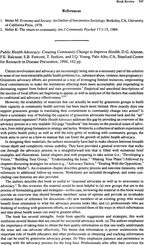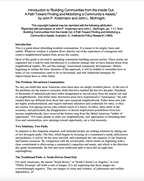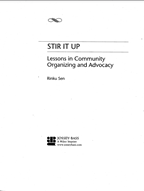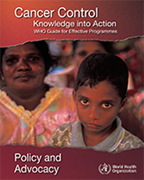How to start advocating for change on stillbirth
Information Brief: Preparing to Advocate
- It is helpful to think about the advocacy process as a series of steps that you can learn. Most of those steps relate to preparation! Before you even begin to “advocate,” you will want to have determined your goal, thought about how you will proceed, and developed a plan.
- In order to make your advocacy efforts effective, you need to:
- Identify the problem or issue you are trying to address
- Break down the problem
- Educate yourself
- Identify your rights/preferences/entitlements or societal expectations related to the problem
- Develop a solution (goal) and strategy to address your challenge
- Goal setting can be different if you are doing self-advocacy. Oftentimes, this type of advocacy strategy is spontaneous, for instance if you would like to address a challenge right away. You may not formally set a goal, but still have an agenda in mind. However, regardless of the type of advocacy you are doing, it’s critical to clarify what you would like to achieve.
- We’ve explored the definition, aims, and types of advocacy, some key skills you need, and the importance of advocacy for stillbirth prevention and respectful bereavement care.
- It is important to choose an advocacy strategy that works for you, whether self-advocacy or group advocacy. Your choice will depend on the issue that needs to be changed, availability of resources to support your strategy, and your personality style. It’s key to note that both self and group advocacy strategies can be implemented either formally or informally. These two types of advocacy strategies have different ways of execution, but either is a valid approach.
Information Brief: Psychological preparation for advocacy work
- Apart from the practical steps of preparation for doing advocacy, it’s also important to check in with your emotional self. Advocacy in any form can open up unhealed emotional wounds connected to your stillbirth experience. That’s why it’s equally essential to explore whether you are psychologically ready to pursue any form of advocacy strategy.
- It’s easy to interpret challenges or roadblocks to stillbirth support through the lens of our personal experiences. However, sometimes, what went wrong for you, might have been right for someone else.
- For example, one bereaved mother might have received the best care at Facility X, while a fellow bereaved mother might have received the worst experience at that same facility.
- The differing experiences of these two bereaved mothers shows that training in respectful bereavement care should be provided for all healthcare professionals, and the mother who had received poor care could decide to advocate for this type of training.
- However, she might say to herself, "I felt so angry because a certain mom praised her doctor for being so supportive during her stillbirth experience."
- A helpful question for that mother to ask herself in this context would be, "Am I reacting angrily towards that doctor, or towards my past hospital experience where I was treated indifferently?"
- This mother might then reflect, "The most probable response would be that I’m reacting towards my hospital experience. This means there is unresolved anger. It would be great to work on my feelings of anger and grief before engaging in any advocacy work."
Checklist: Steps for Self-Advocacy Strategies
| Step | To consider | Case study for discussion |
|---|---|---|
| 1. What is the problem or issue? | Before starting to advocate in whatever capacity, it’s important to critically explore all the issues. The problems might be many, but choose to focus on one. | A bereaved mom, Lily, has been denied two extra weeks for her recovery post-stillbirth at her workplace. The Human Resources Manager mentions she doesn’t want to give anyone special treatment and the leave previously given should have been enough. Lily feels frustrated because her doctor is out of town yet she would have requested a letter indicating her current state to allow her get more days for recovery. What are the key issues in this case that need to be addressed? |
| 2. What is your goal? | After identifying the problem, set a goal for your preferred outcome. | Is your goal to create awareness of the need for better support for bereaved parents in the workplace? Or to partner with relevant agencies in order to petition for the amendment of the current Employment Act to include bereavement leave? Or simply to get the extra days of leave from your Human Resources manager? |
| 3. What facts do you know? | Identifying the facts means recollecting what you know about the situation and outlining the events that happened with objectivity. | From the above example of Lily’s experience, what are the facts of her story? |
| 4. What additional facts or information might you need regarding this situation, such as rights, laws, rules or policies? | It’s important to have your facts supported by rights, policies or laws. You can research additional facts through reaching out to key persons such as advocates, agencies in charge of patients’ welfare, or advocacy groups. The
internet can also provide a wealth of information to support your facts. However, you need to be careful about the sites that you use. | Is it possible for Lily to explore the organizational policies and procedures on getting extra leave days? Can Lily inquire from the worker’s union to get more information on how to go about her advocacy work? |
| 5. How can you go about gathering this information? | Gathering information means contacting the right person to help you gain more facts, for instance advocates, or advocacy/peer groups. A fellow bereaved parent can also empower you with more information to help you address the issue. This means reaching out to peer support groups which can be found online to find fellow bereaved parents. | Who are the ideal people for Lily to engage with in order to gain more information on bereavement leave? |
| 6. Who are the decision-makers you need to influence to solve this problem/issue? | These are individuals whom you can approach to address the issue i.e. healthcare administrators, media, religious leaders, chief or village elders, Human Resources staff, etc. | Who will be the best person for Lily to approach in solving the bereavement leave issue? Does it depend on her advocacy goal? |
| 7. What are some possible solutions to this problem/issue? | Be specific about solutions! Knowing your rights or preferences will help you to identify possible solutions. Ask yourself, What do I really want? | In Lily’s case, what would be the best solution if her goal is to get more days off from work? |
| 8. What are some barriers to these solutions? | It will be helpful to consider what challenges are bound to develop as you pursue this advocacy strategy. For example, your concern might be dismissed or it might take resources such as money and time that are unavailable. It might be frustrating trying to educate someone on better support mechanisms for the bereaved. You might need to explore those probable barriers. | What are the possible barriers to Lily’s advocacy efforts? |
The above content is adapted from Teacher’s Guide, Freedom Self-Advocacy Curriculum, National Mental Health Consumers’ Self-Help Clearinghouse (April 2000 Pilot Version), p. 18.
Guidelines: Stakeholder Analysis
- A stakeholder analysis highlights which institutions and individuals have a stake in an issue, as well as their interests, support or opposition, influence and importance. A stakeholder analysis involves four steps:
| Step | To consider |
|---|---|
| 1. Identify the key stakeholders from the large array of groups and individuals that could potentially affect or be affected by your advocacy initiative. | These may include senior government officials, individuals from the Ministry of health or finance, non-profit organizations in maternal health and reproductive health, private sector hospital management, etc. |
| 2. Assess stakeholder interests and the potential impact of your advocacy work on these interests. | § What are each stakeholder’s expectations or beliefs in relation to your work in advocating for respectful care for bereaved parents after stillbirth and ending preventable stillbirths? § What benefits are likely to result for the stakeholders from this advocacy work, if any? § What resources might the stakeholders be able and willing to mobilize for it? § What stakeholder interests may conflict with your advocacy goals? |
| 3. Assess the influence and importance of the identified stakeholders. Influence refers to the power that stakeholders might have in creating change in care after stillbirth or ending preventable stillbirths. | Do the stakeholders have formal or informal control over the decision-making process? (Informal control means that their control is only related to facilitating your advocacy initiative.) Stakeholders who are important are often those who are likely to benefit from your advocacy work, or whose objectives converge with the objectives of the advocacy work. It is possible that some stakeholders who are very important might have very little influence, or vice versa. |
| 4. Outline a stakeholder participation strategy. This plan states ways in which the different stakeholders will ideally be involved in different stages of the advocacy planning and implementation. | It will be important to plan the involvement of stakeholders according to: § The interests, importance, and influence of each stakeholder. § The particular effort needed to involve important stakeholders who lack influence. § Appropriate forms of participation throughout the advocacy cycle. |
The stakeholder power analysis has been adapted from TASCO, SIPU International. (2011). Advocacy and Policy Influencing for Social Change.
Guidelines: Power analysis
- Another key tool is power analysis, which builds on stakeholder analysis. A power analysis helps in identifying more details about the key decision makers (both institutional and individual) who hold power or influence over the issue you are advocating to change.
- The task is to identify who makes the decisions and who can directly influence these decisions. Remember: Decision-makers can be allies or opponents!
- Examples of possible decision-makers including the Cabinet secretary in charge of the Ministry of Health, a senator, a member of Parliament, staff in hospital management, or the chief of a local area.
- The diagram below illustrates the basic concept of power analysis; for instance, a leader may be in a position of influence but have low interest in your advocacy initiative, whilst another leader has limited power but is highly interested in your cause.

This image has been adapted from the UNSCR United Nations Security Council Resolution 1325 (2000) Advocacy Training Manual.
Information Brief: How to deal with opposing views
- Prevention technique: It’s very common to experience opposition while pursuing your advocacy strategy, whether using self-advocacy or group advocacy. Planning in advance will help you figure out what to do and how to convince potential opponents to either join or not to actively oppose you.
- Meeting people/organizations with opposing views: It would be great to hear their opinions and you may find that the apparent opposition is caused by miscommunication or lack of understanding about the issue.
- Developing win-win solutions: Exploring the solutions that would possibly meet both of your shared interests can help in dealing with your opponents.
- Turning negatives to positives: If attacked by your opponents, whether in legal cases or confrontations, you can transform the words of the attack into educational and advocacy material to help your community better understand what you are facing, and hopefully to gather their sympathy and support.
- Act preemptively to build stronger relationships with those who MAY be opponents, so that they end up as allies instead: For instance, some bereaved parents face cases of stillbirth related to provider negligence, e.g. if providers ignored their concerns during pregnancy or labor such as reduced fetal movement. It is possible that building stronger communication and mutual respect in provider-patient relationships can reduce instances of mothers’ concerns being dismissed, ultimately leading to better outcomes for mothers and babies. However, it is also important that parents ought not to blame themselves for the quality of their relationships with their providers.
- Consider your opponents’ position: Your opponent may in fact also be seeking solutions to the challenges you have identified but due to lack of information, they may have given up or even be opposed to your solutions (perhaps the solutions appear too costly or ineffective to them); if so, your group may be able to join in their effort. For instance, they may be aware of the mental health challenges experienced by parents bereaved by stillbirth but they haven’t figured out yet the basic strategies to address this challenge or feel they are not worth the investment. You can educate your opponents and turn them into allies.
Fact sheet: Some challenges of advocacy
| Self-advocacy | Group advocacy |
|---|---|
| 1. Lack of support- it can get lonely and overwhelming as you advocate for yourself. | 1. Lack of dedicated resources, time, and funding. |
| 2. Inadequate resources to finance your advocacy activities. | 2. Challenges in relationship building with policy makers, influencers and key community leaders. |
| 3. Facing resistance from the targets, possible dismissal of the issue. | 3. Needing enhanced capacity to understand how the system works i.e. healthcare leadership. |
| 4. Inadequate or lack of training/knowledge in advocacy skills and dealing with opposition. | 4. Limited credibility and recognition from policy makers & community leaders, especially if your organization is not registered. |
| 5. Lack of self-determination and leadership development. You may question your advocacy efforts or find yourself seeking the approval of others, instead of focusing on your goals and what that advocacy initiative would mean to you. | 5. Need for persistence and a focus on monitoring change- it’s easy to be discouraged, but advocacy calls for resilience and continuously pushing your agenda as you seek change. |
| 6. Lack of opportunities to take risks and make decisions. | 6. Need for innovation- continuous evaluation of advocacy activities is required; new approaches need to be implemented to ensure success. |
- Overcoming these challenges and moving forward with your advocacy work requires core advocacy skills, including:
- Strategic thinking skills, to help you to identify your goals, ideal allies and targets that you can work with as you address the challenges in your community/society.
- Persuasion skills, to help get others to support your position. This is especially true if you will have an ongoing and hopefully collaborative and constructive relationship with allies.
- Communication skills, including being respectful and confident in spoken and written language.
- Patience, since advocacy work is a process that can take a long time.
- Resilience, to help you in navigating challenges.
- Collaborative skills, to ensure effective interpersonal and team work.
Information Brief: How to do monitoring and evaluation for advocacy work
- As you start advocating for your rights or preferences either individually or within a group, it is essential to assess the impact of your advocacy activity.
- For example, you might have proposed to engage with a local hospital through creating a peer support group for bereaved parents. Your goal is probably to offer peer support and help parents get professional support if the need arises. As you go about implementing your advocacy activities, it would be helpful to assess their impact.
- For instance, you could collect feedback from the peer support group members and explore whether they feel supported. This would help you identify areas you need to improve on or decide whether to outsource further support, if possible.
- You should bear in mind that you might not achieve all your intentions through one cycle of advocacy work; this is totally understandable. Small advocacy efforts will ultimately produce bigger results in time.
- Assessing your progress can include:
- Keeping records of meetings attended or conversations with friends/family/colleagues/community leaders or healthcare professionals.
- Following through on conversations about stillbirth in the healthcare system, or with community leaders, research organizations, policy leaders or the media.
- It would be helpful to evaluate your impact through asking questions such as:
- Have I achieved my goals or intentions?
- How many meetings have I had with targets: an employer, a friend, a doctor or community leader?
- What were the outcomes of those meetings?
- What actions were taken by these targets: an employer, a friend, a doctor or community leader?
- Is the situation better than before? In what ways?
- If there is no change, how might I change my advocacy methods?
- What would I do differently next time?
Information Brief: Examples of possible stillbirth advocacy activities
| Hospital – Hospital Administration | Place of Work | Home/ Neighborhood/ Religious Group/ Local Area |
|---|---|---|
| 1. Advocate for training of health care professionals in respectful bereavement care and basic psycho-social support skills to address poor communication, insensitivity and stigma. | 1. Advocate for inclusion of friendly human resource policies such as bereavement leave for employees experiencing perinatal loss. | 1. Partner with local media stations in creating awareness on pregnancy and infant loss and sharing on ways of offering quality support. Write blogs, articles or journals addressing the shame and stigma. |
| 2. Advocate for referral options for mental health support i.e., employment of a resident counselor or referrals to a counselor after loss. | 2. Partner with parent support organizations in advocating for the amendment of Employment Rights laws and policies to include bereavement leave for parents dealing with miscarriage and stillbirth. | 2. Partner with parent support organizations in creating campaigns to raise awareness on perinatal loss to address the stigma and shame. |
| 3. Suggest to the hospital administration to fund, or raise funds for, the allocation of a private room in the maternity ward for bereaved mums. | 3. Partner with mental health professionals in training the Human Resource Department in basic psychosocial support skills to empower them on how best to support a grieving employee. | 3. Create peer support groups for bereaved families to empower each other on grief support and to learn how to speak for themselves and on behalf of others. |
| 4. Prepare brochures with basic information on coping with perinatal grief and share with the hospital, to be placed at the maternity ward. | 4. Advocate for mental health wellness programs at work such as resident counselors or seminars to empower the team on basic psychosocial skills. | 4. Engage the local hospital in organizing public meetings to raise awareness on pregnancy and infant loss and empower the community in supporting the bereaved. |
| 5. Partner with hospitals’ health education department in preparing seminars for expectant parents to learn the basics of healthy pregnancies and danger signs. | 5. Partner with local government and hospitals in advocating for quality healthcare such as periodic trainings for midwives, raising funds to build a NICU unit or a theatre in the local hospital, or including key amenities, i.e. maternity sanitary towels. | |
| 6. Advocate for the inclusion of parent support organizations in health administration meetings on matters related to maternal and child health. | 6. Organize pregnancy and infant health workshops in partnership with hospitals to train the community on healthy pregnancy, both physically and psychologically. | |
| 7. Advocate to the hospital administration for the initiation of debriefing sessions at the facility level for healthcare professionals’ mental wellbeing. | 7. Partner with parent support organizations and hospitals in advocating to the county government for more healthcare professionals to be stationed at maternity wards/reproductive units to encourage quality healthcare. | |
| 8. Start and encourage peer bereavement support groups at the hospital or other locations. | 8. Organize memorial events for bereaved parents and their families, i.e. tree planting, candle lighting. | |
| 9. Visit bereaved families at the hospital to offer support. | 9. Support a bereaved parent during the funeral ceremony for their baby. |
Guidelines: What to say and what Not to say
What to say to bereaved parents:
- Use simple and straightforward language
- Be comfortable sharing emotions
- Listen to the parents
- You can say:
- "I'm sorry"
- "I wish things could have ended differently"
- "I wish this pregnancy turned out as you had hoped"
- "This must be hard for you"
- "I am sad for you"
- "I’m here; I want to listen"
What not to say to bereaved parents:
- "It was God’s will"
- "I know just how you feel"
- "Now you have an angel in heaven"
- "At least you have other children"
- "Be strong"
- "It was not meant to be" (or any mention of fate)
- "At least you know you can get pregnant"
- "It was just a cluster of cells"
- "At least it was nice and early"
- "Everything happens for a reason"
DIG DEEPER!
Resources and studies

This document explains the differences in rights, policies and preferences in advocacy work.Learn more

A New Weave of People, Power and Politics: The Action Guide for Advocacy and Citizen Participation
This document provides the steps of identifying an advocacy strategy and explains the ways of implementing group and systemic advocacy strategies.More...

This book is useful to both seasoned advocates and newcomers as it provides ways of formulating goals and strategies for community health advocates and...

Introduction to "Building Communities from the Inside Out: A Path Toward Finding and Mobilizing a Community's...
This paper provides links to case studies of successful community-building initiatives across the U.S. In addition to this, it outlines how a community...

In this document, Sen’s works have been highlighted as he goes step-by-step through the process of building and mobilizing a community and implementing...

WHO Guide for Effective Programs: Module 6: Policy and Advocacy
This article highlights the steps of monitoring and evaluation in advocacy work.More information

The Advocacy Initiative Legacy
This website explores the challenges faced by community and voluntary organizations in carrying out their advocacy work.More information

.png?sfvrsn=6d0e27cd_1)



